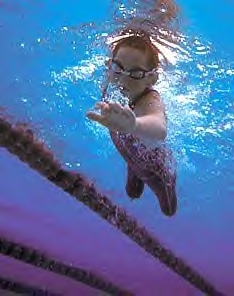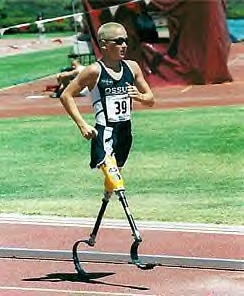 |
Rudy Garcia-Tolson was tired of the operations. There already had been 15. From the moment he was born, Rudy had endured surgeries to correct his cleft lip and palate as well as his nose and webbed hands. Though the procedures were successful, one hurdle remained: Rudy’s legs.
Webbed beneath his knee, Rudy’s curled legs confined him to a wheelchair.
Numerous surgeries had done nothing. Although at birth doctors told his parents that his legs should be amputated, Sandra and Ricardo didn’t want to give up so quickly. Doctors tried to remove the skin that tightly bound Rudy’s legs, but it was part of the central nerve that ran behind his knees. Doctors shortened his femur hoping that his legs would straighten, but they did not. By the time Rudy was 4, his parents, Sandra and Ricardo, were open to anything.
Rudy’s right leg was wrapped in what was essentially a steel cage. One-inch pins connected to the cage were pushed into the bones of Rudy’s leg. Each day, his mother turned a knob on the side of the cage one millimeter and with each turn, the bones in Rudy’s leg were stretched.
The skin surrounding the 20 pins often became infected and Sandra would have to clean the pins everyday, sometimes two or three times. To stave off infection, Rudy took a myriad of antibiotics. Not always wanting to be confined to his wheelchair, Rudy dragged himself through the house, pulling his cage along the carpet. When Sandra lifted him from the floor, the weight of the cage was overwhelming and he was forced to hold his leg with his 4-year-old hands. Sometimes, while crawling on the floor, Rudy’s cage would slip beneath his mother’s feet. Unavoidably, Sandra would step down on her son’s struggling leg.
The cage remained a part of Rudy for six months. While his leg was wrapped in steel and embedded with pins, Rudy knew he would have to endure another six months of this torture to straighten his left leg. Or, worse yet, the cage would fail and his legs would remain curled.
At first, things went as planned. The cage was removed. Rudy’s right leg was straight and longer than his left. Wrapped in a cast from the waist down, his leg remained confined for two months.
Yet, after the cast was removed, Rudy’s leg almost immediately recurled. Sandra and Ricardo were out of options, the doctors were out of ideas and Rudy had suffered enough.
“Cut them off,” Rudy emphatically told the doctors, “cause I want to go out and play.”
At the age of 5, Rudy’s legs were amputated below the knee. The surgery took several hours and when he woke, Rudy immediately asked his father to take him for a ride in his wagon.
For Rudy, this meant taking a walk. He and his father would often go outside so Rudy could see the world that lay just outside his Bloomington, California home.
But after his surgery, it was enough for Rudy to just see beyond the hospital room that would be his home for the next week. As he and his father enjoyed their walk, Rudy knew he had left behind his operations, his wheelchair and his legs. And he knew that, soon, when he wanted to go for a walk, he wouldn’t need the wagon anymore.
When Rudy left the hospital, doctors told him to stay off the surgical casts that covered his stumps. They told him not to walk, but he had waited too long for this day. He wanted to make up for lost time.
Sandra and Ricardo took Rudy back to the hospital three times to replace his broken, surgical casts. Once the casts came off for the last time, Rudy was fitted with a pair of prosthetic legs.
Technological advancements had made possible prosthetic legs that could stand up to anything. But Rudy did not receive those legs. He and his family were on MediCal, which offered less durable prosthetics.
Simply walking on his new legs was not enough. Rudy walked up and down the stairs. He climbed the wall in the backyard. He climbed trees. He tried to ride a bike. He did the things any 5-year-old boy would do, but Rudy’s artificial legs were too weak to keep up with him.
MediCal offered only one pair of legs a year, so when Rudy and his “broken legs” arrived at the hospital, doctors didn’t know what to do. As fast as they would fix them, Rudy would break them. Shortly after his surgery, desperate doctors wrapped Rudy’s new — but broken — legs in bungee cords. Sandra knew something had to be done.
With her video camera, Rudy’s mother recorded her son’s phenomenal activities. She knew that someone needed to see all that this, now 6-year-old, bilateral amputee was accomplishing. The financial strain of buying the technological support was out of her reach. She just knew that all her son needed was a better pair of legs.
The video, along with a letter, was sent to Flex-Foot, a manufacturer of technologically advanced carbon fiber, prosthetic feet. Flex-Foot responded. They donated a foot to Rudy and, soon after, a new knee arrived.
Now, anything was possible and Rudy was ready for it all. Things were quite different than they had been in the weeks following his surgery. Shortly after his legs were amputated, Rudy became depressed and began seeing a counselor.
Seeing no change in his behavior, his kindergarten teacher suggested Sandra and Ricardo find a sport for their son.
With a release from his doctor, he went to a therapeutic pool twice a week. At first, he did not want to be there, but after two weeks he was swimming. He was supposed to be relaxing in the soothing 100-degree water, but instead he was splashing around in the pool. Ready for more challenges, Rudy decided to join a swim team.
Sandra took him to the YMCA and after a tryout, he was on the team. After a year of meets, Rudy was bored — not with swimming but with his competition. Rudy always won. Every race. Every swimmer. Everytime he jumped in the pool. With hopes of finding greater challenges, Rudy joined the USA Swimming Team.
But the sport was expensive.
Rudy’s parents needed help, so Sandra began writing letters again to as many corporations as she could think of to request sponsorship. She told them all about what her son had endured. She told them about his 15 surgeries. She told them he could run, climb and swim.
The letters went to companies like General Motors, Microsoft, Gatorade and Ford, who all said “no.” Then someone suggested PowerBar and Rudy found a sponsor. At first, they only sent products and stickers, but Rudy was a proud member of his new team. He wore his PowerBar T-shirt and stuck stickers on his legs.
With a profound desire for new adventure, Rudy began running, but his first race did not go as planned. On the way to the one-mile kid's race, his father’s truck broke down and Rudy missed his race. Though he was too late to compete, Rudy walked around the event and someone noticed the stickers on his legs. After telling the man he was a member of Team PowerBar, Rudy was offered the chance to participate in a triathlon. Rudy would swim, and professional triathlete Terry Martin would run and bike.
The pair took first place and Rudy was hooked. He realized that he was capable of doing anything he wanted to do.
 |
Now at 13, Rudy still competes in triathlons, but he doesn’t stop there. He plays football, baseball, basketball and hockey. He rides his skateboard and dreams of the day when he will represent his country in the Paralympics. And along with his role as an athlete, Rudy has also become a public speaker.
He began telling his story to corporations, grade schools and universities, discussing the Pterygium Syndrome that caused his condition. He talks about all he and his family have endured and he explains that no one should let a challenge stand in their way.
Earlier this year, he spoke at the opening ceremonies of the 2002 Paralympic Winter Games. Along with speakers representing mind and body, Rudy represented spirit. When the summer games come along, he hopes to not just participate, but to compete. Training five days a week, for two hours a day, Rudy hopes to enter the games as a swimmer, a runner or a triathlete. And if he doesn’t make the 2004 team, Rudy will try for 2008.
When he becomes a freshman at Bloomington High School this fall, he hopes to join the swim team, as well as run cross-country and track. But before he runs for his school, Rudy had a chance to run for the world.
With his mother looking on, a young boy, who dared to imagine that with a brave heart anything is possible, ran the Olympic flame down the streets of San Francisco. Running on legs that had been waiting for him all along.
Page created on 6/14/2004 12:41:09 PM
Last edited 8/19/2018 6:10:49 PM
